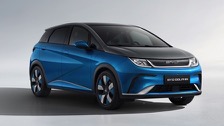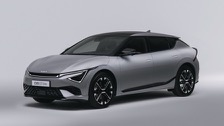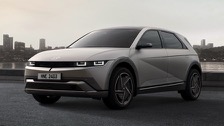Volkswagen ID.3 GTX
Expected from December 2024£43,000 *Price from
79.0 kWhUseable Battery
285 mi *Real Range
277 Wh/mi *Efficiency
This electric vehicle is not available yet
Specifications with an * are estimates.Price from * £43,000
| Availability | Expected |
| Available to order from * | December 2024 |
| Available to order until | - |
Lease (BCH) from * £0 pcm
| Annual VED | £0 |
| Congestion Charge * | £0 |
| Insurance Group | N/A |
Real Range Estimation between 205 - 415 mi
| City - Cold Weather * | 275 mi |
| Highway - Cold Weather * | 205 mi |
| Combined - Cold Weather * | 240 mi |
| City - Mild Weather * | 415 mi |
| Highway - Mild Weather * | 260 mi |
| Combined - Mild Weather * | 325 mi |
Performance
| Acceleration 0 - 62 mph | 5.9 sec |
| Top Speed | 112 mph |
| Electric Range * | 285 mi |
| Total Power | 210 kW (282 hp) |
| Total Torque | 402 lb-ft |
| Drive | Rear |
Battery
| Nominal Capacity | 84.0 kWh |
| Battery Type | Lithium-ion |
| Number of Cells | 288 |
| Architecture | 400 V |
| Warranty Period | 8 years |
| Warranty Mileage | 100,000 mi |
| Useable Capacity | 79.0 kWh |
| Cathode Material | NCM |
| Pack Configuration | 96s3p |
| Nominal Voltage | 352 V |
| Form Factor | No Data |
| Name / Reference | No Data |
Charging
Home / Destination
| Charge Port | Type 2 |
| Port Location | Right Side - Rear |
| Charge Power † | 11 kW AC |
| Charge Time (0->285 mi) † | 8h30m |
| Charge Speed † | 34 mph |
Rapid Charging
| Charge Port | CCS |
| Port Location | Right Side - Rear |
| Charge Power (max) | 185 kW DC |
| Charge Power (10-80%) | 135 kW DC |
| Charge Time (28->228 mi) | 26 min |
| Charge Speed | 460 mph |
| Autocharge Supported | No |
Plug & Charge
| Plug & Charge Supported | Yes |
| Supported Protocol | ISO 15118-2 |
Bidirectional Charging (V2X / BPT)
Vehicle-to-Load (V2L)
| V2L Supported | No |
| Max. Output Power | - |
| Exterior Outlet(s) | - |
| Interior Outlet(s) | - |
Vehicle-to-Home (V2H)
| V2H via AC Supported | No |
| Max. Output Power | - |
| V2H via DC Supported | Announced |
| Max. Output Power | No Data |
Vehicle-to-Grid (V2G)
| V2G via AC Supported | No |
| Max. Output Power | - |
| V2G via DC Supported | Announced |
| Max. Output Power | No Data |
Energy Consumption
EVDB Real Range
| Range * | 285 mi |
| Vehicle Consumption * | 277 Wh/mi |
| CO2 Emissions | 0 g/km |
| Vehicle Fuel Equivalent * | 146 mpg |
WLTP Ratings
| Range | 375 mi |
| Rated Consumption | 233 Wh/mi |
| Vehicle Consumption | 210 Wh/mi |
| CO2 Emissions | 0 g/km |
| Rated Fuel Equivalent | 173 mpg |
| Vehicle Fuel Equivalent | 192 mpg |
Vehicle = calculated battery energy consumption used by the vehicle for propulsion and on-board systems.
NOTE: The fuel equivalency figures are shown in IMPERIAL MPG. Figures in US MPG will differ significantly.
Real Energy Consumption Estimation between 190 - 385 Wh/mi
| City - Cold Weather * | 287 Wh/mi |
| Highway - Cold Weather * | 385 Wh/mi |
| Combined - Cold Weather * | 329 Wh/mi |
| City - Mild Weather * | 190 Wh/mi |
| Highway - Mild Weather * | 304 Wh/mi |
| Combined - Mild Weather * | 243 Wh/mi |
Dimensions and Weight
| Length | 4322 mm |
| Width | 1809 mm |
| Width with mirrors | 2070 mm |
| Height | 1538 mm |
| Wheelbase | 2770 mm |
| Weight Unladen (EU) | 1985 kg |
| Gross Vehicle Weight (GVWR) | 2430 kg |
| Max. Payload | 520 kg |
| Cargo Volume | 385 L |
| Cargo Volume Max | 1267 L |
| Cargo Volume Frunk | 0 L |
| Roof Load | 0 kg |
| Tow Hitch Possible | No |
| Towing Weight Unbraked | 0 kg |
| Towing Weight Braked | 0 kg |
| Vertical Load Max | 0 kg |
Miscellaneous
| Seats | 5 people |
| Isofix | No Data |
| Turning Circle | 10.5 m |
| Platform | VW MEB |
| EV Dedicated Platform | Yes |
| Car Body | Hatchback |
| Segment | C |
| Roof Rails | No |
| Heat pump (HP) | Yes |
| HP Standard Equipment | No, optional |
Company Car Tax Indication
Financial Year 2024-25
| BIK Tax Rate | 2% |
| P11D Value from * | £42,945 |
| Benefit in Kind (BIK) * | £859 |
| BIK @ 20% * | £14 pcm |
| BIK @ 40% * | £29 pcm |
| BIK @ 45% * | £32 pcm |
Financial Year 2025-26
| BIK Tax Rate | 3% |
| P11D Value from * | £42,945 |
| Benefit in Kind (BIK) * | £1,288 |
| BIK @ 20% * | £21 pcm |
| BIK @ 40% * | £43 pcm |
| BIK @ 45% * | £48 pcm |
Financial Year 2026-27
| BIK Tax Rate | 4% |
| P11D Value from * | £42,945 |
| Benefit in Kind (BIK) * | £1,718 |
| BIK @ 20% * | £29 pcm |
| BIK @ 40% * | £57 pcm |
| BIK @ 45% * | £64 pcm |
Similar electric vehicles
 BYD DOLPHIN 60.4 kWh £12,805 less expensive 70 mi less range 19% slower acceleration Similar energy consumption 53% slower rapid-charging
BYD DOLPHIN 60.4 kWh £12,805 less expensive 70 mi less range 19% slower acceleration Similar energy consumption 53% slower rapid-charging Kia EV6 RWD £2,575 more expensive 15 mi less range 24% slower acceleration 5% less energy efficient 46% faster rapid-charging
Kia EV6 RWD £2,575 more expensive 15 mi less range 24% slower acceleration 5% less energy efficient 46% faster rapid-charging Hyundai IONIQ 5 84 kWh RWD £400 more expensive 10 mi less range 27% slower acceleration 3% less energy efficient 50% faster rapid-charging
Hyundai IONIQ 5 84 kWh RWD £400 more expensive 10 mi less range 27% slower acceleration 3% less energy efficient 50% faster rapid-chargingHome and Destination Charging (0 -> 100%)
Charging is possible by using a regular wall plug or a charging station. Public charging is always done through a charging station. How fast the EV can charge depends on the charging station (EVSE) used and the maximum charging capacity of the EV. The table below shows all possible options for charging the Volkswagen ID.3 GTX. Each option shows how fast the battery can be charged from empty to full.
| Type 2 (Mennekes - IEC 62196) |
|---|
 |
| Charging Point | Max. Power | Power | Time | Rate |
|---|---|---|---|---|
| Wall Plug (2.3 kW) | 230V / 1x10A | 2.3 kW | 40h30m | 7 mph |
| 1-phase 16A (3.7 kW) | 230V / 1x16A | 3.7 kW | 25h15m | 11 mph |
| 1-phase 32A (7.4 kW) | 230V / 1x32A | 7.4 kW | 12h45m | 22 mph |
| 3-phase 16A (11 kW) | 400V / 3x16A | 11 kW | 8h30m | 34 mph |
| 3-phase 32A (22 kW) | 400V / 3x16A | 11 kW † | 8h30m | 34 mph |
† = Limited by on-board charger, vehicle cannot charge faster.
Rapid Charging (10 -> 80%)
Rapid charging enables longer journeys by adding as much range as possible in the shortest amount of time. Charging power will decrease significantly after 80% state-of-charge has been reached. A typical rapid charge therefore rarely exceeds 80% SoC. The rapid charge rate of an EV depends on the charger used and the maximum charging power the EV can handle. The table below shows all details for rapid charging the Volkswagen ID.3 GTX.
- Max. Power: maximum power provided by charge point
- Avg. Power: average power provided by charge point over a session from 10% to 80%
- Time: time needed to charge from 10% to 80%
- Rate: average charging speed over a session from 10% to 80%
| Combined Charging System (CCS Combo 2) |
|---|
 |
| Charging Point | Max. Power | Avg. Power | Time | Rate |
|---|---|---|---|---|
| CCS (50 kW DC) | 50 kW | 50 kW | 70 min | 170 mph |
| CCS (100 kW DC) | 100 kW | 90 kW † | 39 min | 300 mph |
| CCS (150 kW DC) | 150 kW | 115 kW † | 30 min | 390 mph |
| CCS (175 kW DC) | 175 kW | 130 kW † | 27 min | 440 mph |
| CCS (350 kW DC) | 185 kW † | 135 kW † | 26 min | 460 mph |
| This vehicle does not support Autocharge |
|---|
| This vehicle supports Plug & Charge |
† = Limited by charging capabilities of vehicle
Autocharge: allows for automatic initiation of a charging session at supported CCS charging stations.
Plug & Charge: allows for automatic initiation of a charging session at supported CCS charging stations in accordance with ISO 15118.
Actual charging rates may differ from data shown due to factors like outside temperature, state of the battery and driving style.
Volkswagen Claimed Specifications
The table below shows the claimed specifications from the manufacturer for charging the Volkswagen ID.3 GTX. The specifications can differ from the table above for a variety of reasons. If real-world charge tests are available, these differences can be signifcant. If no real-world tests are available, the table above will be based on the manufacturer specifications as per the table below.
- Max. Power: maximum charge power during charging session
- Charge From: battery percentage (% SoC) where charging session is started
- Charge To: battery percentage (% SoC) where charging session is ended
- Time: time needed for charging session
| Volkswagen Claimed Specifications |
|---|
| Max. Power | Charge From | Charge To | Time |
|---|---|---|---|
| 185 kW | 10 % | 80 % | 26 min |
All about the Volkswagen ID.3 GTX
Pricing
The Volkswagen ID.3 GTX has an estimated On The Road Price (OTR) of £43,000. The OTR Price includes VAT, first year of VED, vehicle first registration fee, number plates and delivery.
Drivetrain and Performance
The Volkswagen ID.3 GTX is a full electric vehicle (BEV). The maximum power of the Volkswagen ID.3 GTX is 210 kW (282 hp). The maximum torque is 402 lb-ft. The Volkswagen ID.3 GTX is rear wheel drive and can accelerate from 0 to 62 miles per hour in 5.9 seconds. The top speed is 112 mph.
Battery and Charging
The battery of the Volkswagen ID.3 GTX has a total capacity of 84 kWh. The usable capacity is 79 kWh. An estimated range of about 285 miles is achievable on a fully charged battery. The actual range will however depend on several factors including climate, terrain, use of climate control systems and driving style.
For example: sustaining high speeds in cold weather could result in a range of around 205 mi. However, driving at low speeds in mild weather will increase the range to around 415 mi.
Charging is done using a Type 2 connector and the on-board charger has a maximum power of 11 kW. This charges a fully depleted battery back to full in around 8 hours 30 minutes. However, a 3-phase grid connection is needed to achieve this. The majority of homes and charge points currently do not have this connection. In most cases the maximum charging power will be 7.4 kW, allowing for a charge time of 12 hours 45 minutes and a charge rate of 23 mph. Charging the car using a regular wall plug will take around 40 hours 30 minutes.
Rapid charging is possible through a CCS connection. The maximum rapid charge power is 185 kW. The battery can't be charged continuously at this power. In an average rapid charge session the average charge power will be around 135 kW. This charges the battery from 10% to 80% in around 30 minutes. A rapid charge like this will add about 195 miles of range.
Energy Consumption
The estimated combined (motorway and city) energy consumption of the Volkswagen ID.3 GTX is about 277 Wh per mile. By comparison, this energy consumption is the equivalent of a fuel consumption of 146 mpg in a traditional petrol car.
The actual energy consumption will depend on several factors including climate, terrain, use of climate control systems and driving style. For example: sustaining high speeds in cold weather could result in an energy use of around 385 Wh per mile. However, driving at low speeds in mild weather will increase the efficiency to about 190 Wh per mile.
CO2 Emission
The Volkswagen ID.3 GTX emits no CO2 during driving. This only includes direct emissions from the vehicle itself. The energy needed to charge the battery might have been (partly) generated by the use of fossil fuels. Vehicles with an internal combustion engine will always emit CO2 during driving. Additionally, CO2 is emitted during the production and transport of fossil fuels.
More information from Volkswagen
The link below will open the page of the ID.3 on the official Volkswagen site.
